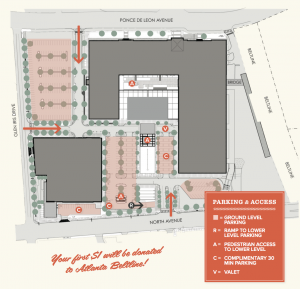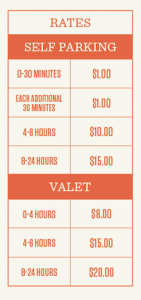In order to meet the demand of Georgian commuters, Ponce City Market’s parking availability is immense. As illustrated by the map above, individuals can access various parking locations via the ground level, lower level, pedestrian ramp, complimentary 30 minute parking, Atlanta Beltline, and valet. The designated areas for vehicular parking range from massive parking garages and adjacent parking lots. The lots located closest to the main level of Ponce City Market are specified for complimentary thirty-minute parking. Due to their ideal locality, the time for each spot is limited. Otherwise, car-users who intend to spend a lengthy amount of time can navigate their way to the parking garage. However, the convenience of Ponce City Market parking comes at a price. The establishment has implemented self-parking fees, a heavily-debated topic for residents. The rates vary, as exhibited in the chart to the right, depending on the time. Gradually, the more time one requires at the site, the more money is required for the use of a parking spot. Many residents have opposed this fee because the market already has expensive prices. Thus, with the use of parking, individuals must dispense more money than they please. Furthermore, individuals perceive the parking fee as another inconvenience for consumers that depend on cars to transport throughout the city of Atlanta. This unwanted fee has subliminal effects in terms of encouraging other modes of transportation such as walking, biking, or public transport. These modes can be positive for lifestyles within the community. For example, the entrance to the Atlanta Beltline advocates healthy, unconventional means of travel that oppose the heavily-dependent vehicular use that exists within metro-Atlanta. Alternatively, negative outcomes contrive from the parking fees. Their mandatory parking fees inflicts implications on consumers who are not willing and/or capable to pay the expense, such as lower-income individuals. Once again, the self-parking rates act as a regressive fee on consumers. Therefore, the expenses occur at a proportionally higher rate for lower-classes. Meanwhile, upper-classes do not undergo the same severity. In order to maintain the development’s refinement, additional fees are required. Unfortunately, the monies that are designated to better the development for years to come further the disparity of socioeconomic classes within Atlanta.

